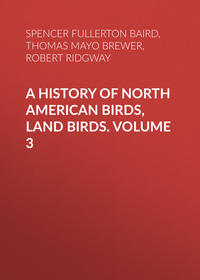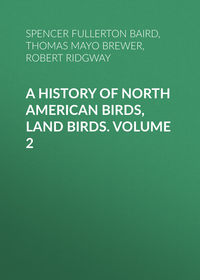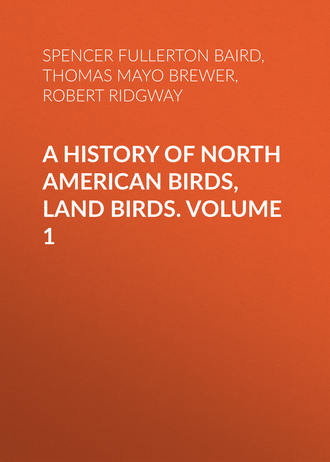 полная версия
полная версияA History of North American Birds, Land Birds. Volume 1
a. Spots much larger on throat and jugulum than elsewhere. Inner webs of second to fifth tail-feathers (between middle and outer feathers) black, except at tips. Length, 8.00; wing, 3.40; tail, 3.55. Hab. Adjacent borders of United States and Mexico … brunneicapillus.
b. Spots on throat and jugulum little larger than elsewhere. Inner webs of intermediate tail-feathers banded with white like the outer. Length, 7.50. Hab. Cape St. Lucas … affinis.
Campylorhynchus brunneicapillus, GrayCACTUS WRENPicolaptes brunneicapillus, Lafresnaye, Mag. de Zool. 1835, 61, pl. xlvii.—Lawr. Ann. N. Y. Lyc. V, 1851, 114.—Cassin, Birds Cal. Tex. 1854, 156, pl. xxv.—Heermann, J. A. N. Sc. II, 1853, 263. C. brunneicapillus, Gray, Genera, I, 1847, 159.—Bp. Consp. 1850, 223.—Scl. P. A. N. S. 156, 264.—Baird, Birds N. Am. 1858, 355; Pr. Phil. Acad. 1859, 3, etc.; Rev. 99.—Heermann, P. R. R. X, 1859.—Dresser, Ibis, 1865, 482 (Texas).—Cooper, Orn. Cal. 1, 1870, 61.
Sp. Char. Bill as long as the head. Above brown; darkest on the head, which is unspotted. Feathers on the back streaked centrally with white. Beneath whitish, tinged with rusty on the belly; the feathers of the throat and upper parts, and under tail-coverts, with large rounded black spots; those of the remaining under parts with smaller, more linear ones. Chin and line over the eye white. Tail-feathers black beneath, barred subterminally (the outer one throughout) with white. Iris, reddish-yellow. Length, 8 inches; wing, 3.40; tail, 3.55.
Hab. Adjacent borders of the United States and Mexico, from the mouth of the Rio Grande to the Valley of the Colorado, and to the Pacific coast of Southern California. Replaced at Cape St. Lucas by C. affinis.
This species is found abundantly along the line of the Rio Grande and Gila, extending northward some distance, and everywhere conspicuous by its wren-like habits and enormous nest.
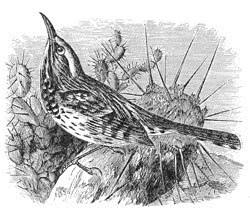
Campylorhynchus brunneicapillus.
Habits. The Brown-headed Creeper is a comparatively recent addition to the fauna of the United States, but appears to be common along the southwestern borders of the United States, from the valley of the Rio Grande to San Diego, in California. In Lower California it is replaced by the C. affinis.
It was first added to our avifauna by Mr. Lawrence in 1851, on the strength of a specimen obtained in Texas by Captain McCown.
Dr. Heermann, in his paper on the Birds of California, speaks of finding it in the arid country back of Guymas, on the Gulf of California. This country, presenting only broken surfaces and a confused mass of volcanic rocks, covered by a scanty vegetation of thorny bushes and cacti, among other interesting birds, was found to contain this species in abundance. He describes it as a lively, sprightly species, uttering, at intervals, clear, loud, ringing notes. Its nest, composed of grasses and lined with feathers, was in the shape of a long purse, enormous for the size of the bird, and laid flat between the forks or on the branches of a cactus. The entrance was a covered passage, varying from six to ten inches in length. The eggs, six in number, he described as being of a delicate salmon-color, very pale, and often so thickly speckled with ash and darker salmon-colored spots as to give quite a rich cast to the whole surface of the egg.
Lieutenant Couch met with these birds near Monterey. He states that they have a rich, powerful song. Of the nest he gives substantially the same description as that furnished by Dr. Heermann.
The eggs are of an oblong-oval shape, slightly more pointed at one end, and are so equally and generally covered, over a white ground, with fine salmon-colored spots, as to present a uniform and almost homogeneous appearance. They vary in length from an inch to 1.02 inches, and have an average breadth of .68 of an inch.
Campylorhynchus affinis, XantusTHE CAPE CACTUS WRENCampylorhynchus affinis, Xantus, Pr. A. N. Sc. 1859, 298 (Cape St. Lucas).—Baird, Pr. A. N. Sc. 1859, 303; Rev. 100.—Scl. Catal. 1861, 17, No. 108.—Elliot, Illust. B. N. A. I, IV.—Cooper, Orn. Cal. 1, 1870, 62.
Sp. Char. Cap of head reddish-brown; the concealed centres of feathers dusky. Rest of upper parts grayish-brown, all the feathers of body and scapulars with broad central or shaft streaks of whitish edged with black; the streaks irregular in outline, on some feathers nearly linear, in others widening at intervals along the shaft. Outer webs of the wing-feathers crossed by about seven rows of whitish semicircular spots, with corresponding series of more circular ones on the inner web. Tail-feathers black, all of them with a series of about eight quadrate white spots on each web, which are alternate to each other, not opposite, and extend from or near the black shaft to the edge; the extreme tips of the feathers black; the two central feathers, however, more like the back, with irregular mottling of grayish and black. Upper tail-coverts barred transversely with black.
Under parts white, faintly tinged with rusty posteriorly; each feather spotted with black, excepting on the immaculate chin. These spots are rather larger and more quadrate on the jugulum, where they are sometimes on the sides of the feathers (on one or both sides); posteriorly, however, they are elongated or tear-shaped, and strung along the shaft, one or two on each. On the crissum they are large and much rounded, three or four on each longer feather. Legs rather dusky. Bill lead-color, pale at the base below; iris reddish-brown. A broad white stripe from bill over the eye and nape; edged above and below with black; line behind the eye like the crown; cheek-feathers white, edged with blackish.
Immature specimens exhibit a tendency to a whitish spotting in the ends of the feathers of the cap. A very young bird does not, however, differ materially, except in having the spots less distinct beneath, the white streaks less conspicuous above, the white of the wings soiled with rufous. Specimens vary considerably in the proportional as well as absolute thickness and length of the bill; thus, No. 32,167 measures .80 from nostril to end of bill, instead of .60, as given below for No. 12,965.
12,965. Total length, 7.50; wing, 3.30; tail, 3.40; its graduation, .45; exposed portion of first primary, 1.42, of second, 2.15, of longest, or fourth (measured from exposed base of first primary), 2.45; length of bill from forehead, .90, from nostril, .60; along gape, 1.07; tarsus, 1.02; middle toe and claw, .90; claw alone, .25; hind toe and claw, .76; claw alone, .35.
Hab. Only observed at Cape St. Lucas, Lower California.
This species is most nearly allied to C. brunneicapillus; the most apparent difference at first sight being in the greater concentration of black on the throat and jugulum in brunneicapillus, and the much smaller size of the remaining spots on the under parts, with the decided light-cinnamon of the posterior portion of the body. The outer and central tail-feathers alone are marked as in C. affinis, the intermediate ones being entirely black, with the exception of a white subterminal band.
This is one of the most characteristic birds constituting the isolated fauna of Cape St. Lucas. Like nearly all the species peculiar to this remarkable locality, it is exceedingly abundant, breeding in immense numbers. It has not yet been detected elsewhere, though it may possibly be found on the Lower Colorado.
Habits. This recently described species was first discovered by Mr. Xantus, and has, so far as is known, a somewhat restricted locality, having been met with only at the southern extremity of Lower California, where it is an exceedingly abundant bird. Mr. Xantus has published no observations in regard to its habits, which, however, are probably very nearly identical with those of the more common species. From the brief memoranda given by him in the general register of his collections, made at Cape St. Lucas, we gather that their nests were built almost exclusively in opuntias, cacti, and the prickly pear, and were generally only four or five feet from the ground, but occasionally at the height of ten feet.
The nests are large purse-shaped collections of twigs and coarse grasses, very similar to, and hardly distinguishable in any respect from, those of the more northern species. The eggs vary from 1.05 to 1 inch in length, and from .65 to .70 of an inch in breadth, and have a reddish-white ground very uniformly dotted with fine markings of reddish-brown, purple, and slate.
Subgenus SALPINCTES, CabanisSalpinctes, Cabanis, Wiegmann’s Archiv, 1847, I, 323. (Type, Troglodytes obsoletus, Say.)
Gen. Char. Bill as long as the head; all the outlines nearly straight to the tip, then decurved; nostrils oval. Feet weak; tarsi decidedly longer than the middle toe; outer lateral toe much longer, reaching to the base of the middle claw, and equal to the hinder. Wings about one fifth longer than the tail; the exposed portion of the first primary about half that of the second, and two fifths that of the fourth and fifth. Tail-feathers very broad, plane, nearly even or slightly rounded; the lateral moderately graduated.
Of this genus but one species is so far known in the United States, the Rock Wren of the earlier ornithologists. It is peculiar among its cognate genera by having the two continuous plates on each side the tarsus divided into seven or more smaller plates, with a naked interval between them and the anterior scutellæ. Other characters will be found detailed in the Review of American Birds, p. 109.
Salpinctes obsoletus, CabanROCK WRENTroglodytes obsoletus, Say, Long’s Exped. II, 1823, 4 (south fork of Platte).—Aud. Orn. Biog. IV, pl. ccclx.—Ib. B. A. II, pl. cxvi.—Newberry, P. R. R. Rep. VI, IV, 1857, 80.—Heermann, P. R. R. Rep. X, 1859, 41. Salpinctes obsoletus, Cab. Wiegmann’s Archiv, 1847, I, 323.—Baird, Birds N. Am. 1858, 357; Rev. 110.—Sclater, P. Z. S. 1859, 371 (Oaxaca).—Cooper, Orn. Cal. 1, 1870, 64. ? Troglodytes latisfasciatus, Licht. Preis-Verzeich. 1831, No. 82.
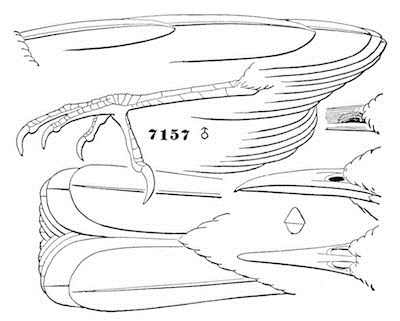
Salpinctes obsoletus.
7157 ♂
Sp. Char. Plumage very soft and lax. Bill about as long as the head. Upper parts brownish-gray, each feather with a central line and (except on the head) transverse bars of dusky, and a small dull brownish-white spot at the end (seen also on the tips of the secondaries). Rump, sides of the body, and posterior part of belly and under tail-coverts dull cinnamon, darker above. Rest of under parts dirty white; feathers of throat and breast with dusky central streaks. Lower tail-coverts banded broadly with black. Inner tail-feathers like the back, the others with a broad black bar near the end; the tips cinnamon; the outer on each side alternately banded with this color and black. A dull white line above and behind the eye. Iris brown. Length, 5.70; wing, 2.82; tail, 2.40. Young not marked or banded beneath. Eggs white, spotted with red.
Hab. Central regions of the United States, to Mexico, east to mouth of Yellowstone River. Cape St. Lucas. Not recorded from Pacific slope. W. Arizona, Coues. Oaxaca, Sclater.
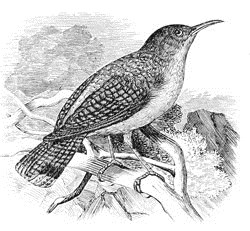
Salpinctes obsoletus.
Habits. The Rock Wren, so far as its distribution is known, is principally restricted to the high central plains of the Rocky Mountains, from Nebraska to the coast ranges near the Pacific, and from Oregon to Mexico and Lower California. According to Dr. Cooper it is an abundant species throughout the dry, rocky, and barren districts of California, especially in the southern portions, where it comes nearer the coast. They are numerous among the plains on both sides of the Rocky Mountains. Their favorite places are among the rocks, where they are always busily engaged in hunting for insects in the crevices. Dr. Cooper found nests at San Diego in cavities under the tiled roofs of houses, but they all contained young as early as May. At Fort Mojave they began to sing in February, and their song continued throughout the spring. They range to a high elevation among the mountains, having been found by Dr. Newberry at Klamath Lake in Oregon. Dr. Cooper does not describe their song, but Dr. Heermann speaks of it as only a very weak trill. The latter met with them in the mountainous districts of California, where they were searching for their food among the crevices of the rocks. He afterwards met with them in New Mexico and Texas. They were quite abundant in the Tejon Valley, passing in and out, among and under the boulders profusely scattered over the mountains, searching for spiders, worms, and small insects, in pursuit of which they uttered at intervals a loud and quick note of a peculiarly thrilling character. Lieutenant Couch found them in the sandstone ranges near Patos, in the province of Coahuila. Some of their habits are spoken of as sparrow-like, and, while they have the usual wren-like grating noises, they also possess a song of great variety and sweetness.
Dr. Kennerly met with them among the bushes in the vicinity of the Rio Grande. Their flight he describes as short, the bird generally soon alighting on the ground and running off very rapidly.
This Wren was first discovered by Mr. Say near the Arkansas River, inhabiting a sterile district devoid of trees, hopping along the ground or flitting through the low, stunted junipers on the banks of the river, usually in small flocks of five or six. Nuttall afterwards found them in July on the Western Colorado. The note of the female was charr-charr-te-aigh, with a strong guttural accent, and with a shrill call similar to the note of the Carolina Wren. The old birds were feeding a brood of five young, which, though full grown, were cherished with querulous assiduity. He found them nesting among the rocky ledges, in the crevices of which they hide themselves when disturbed. Mr. Nuttall also met with this species near Fort Vancouver. Mr. Salvin states that in several instances it has been met with in Guatemala.
The eggs of this Wren obtained by Dr. Palmer in Arizona have a clear white ground, sparingly spotted with well-defined, distinct dottings of brownish-red. These are chiefly distributed around the larger end. They vary somewhat in size and shape, some being of a more rounded form, though all have one end more pointed than the other. The length is pretty uniform, .77 of an inch. The breadth varies from .60 to .66 of an inch. They are larger and more oblong than the eggs of any other Wren, except perhaps the mexicanus, and bear little resemblance to any other eggs of this family with which I am acquainted, except those of the Winter Wren, and the egg attributed to T. americanus.
The nest is homogeneous in structure, composed entirely of thin strips of reddish-colored bark and fine roots, interspersed with a few small bits of wool. It is distorted by packing, so that measurements of it would be valueless; its dimensions in its pressed condition are: diameter, 5 inches; depth, 2 inches. The cavity is shallow and saucer-shaped.
From Mr. Ridgway we learn that from the summit of the Sierra Nevada eastward, as far as the party explored, he found this Wren universally distributed. In the middle provinces of the Rocky Mountains it was the most abundant species of the family, but was not so abundant in the Wahsatch Mountains. The general resort of this species was among rocky or stony hill-slopes, though it was not confined to such localities. At Carson City he found it particularly partial to the rubbish of the decaying pine-logs. At Virginia City it was the only Wren seen frequenting the old buildings and abandoned mining-shafts, in its predilection for such places reminding him very much of the Thryothorus ludovicianus, which in its manners it very strongly resembles.
Mr. Ridgway noticed a wonderful variety in the notes of this Wren. Its peculiarly guttural turee was repeatedly heard, and its song in spring had a slight resemblance in modulation to that of the Carolina Wren, though altogether lacking the power and richness so characteristic of the superb song of that bird. Frequently its song was changed into a prolonged monotonous trill, similar to the tremulous spring-call of the Junco hyemalis.
This species is not so wary as the Catherpes mexicanus. Upon suddenly starting up an individual of this kind, he would fly to the nearest boulder, turn with his breast towards the party, swing oddly from side to side, all the while ludicrously bowing and scolding the intruder with his peculiar sharp expressions of displeasure.
Dr. Cooper, in his paper on the Fauna of the Territory of Montana, states that he observed this bird occasionally through the main Rocky Mountain chain to near the crossing of the Bitterroot, but it was less common than among the cliffs and rocks of the barren plain along their eastern slope. Though he did not find it in the western part of Washington Territory, he has no doubt that it frequents parts of the rocky cañons of the Columbia Plain. A nest with nine eggs was found in a log-cabin below Fort Benton.
Genus CATHERPES, BairdCatherpes, Baird, Birds N. Am. 1858, 357. (Type, Thryothorus mexicanus, Sw.)
Gen. Char. Bill longer than the head, slender; all the outlines nearly straight to the tip, then gently decurved, gonys least so; nostrils linear; tarsus short, about equal to the middle toe, which reaches to the middle of the middle claw. Outer toe considerably longer than the inner, reaching beyond the base of the middle claw. Wings a little longer than the tail; the exposed portion of the first primary about half that of the fourth and fifth. Tail-feathers very broad and perfectly plane; tail nearly even; the two lateral graduated; the outer about eleven twelfths of the middle.
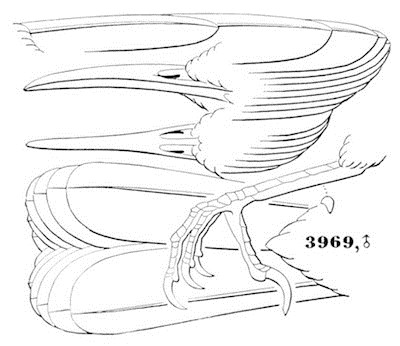
Catherpes mexicanus.
3969, ♂
This genus agrees with Salpinctes in the broad, plane tail-feathers, but the bill is much longer, the nostrils linear, not oval, the feet much stouter, the outer toe rather longer; the tarsus shorter, being equal to the middle toe, not longer; the hind toe much longer than the outer lateral, instead of equal to it. The wings are but little longer than the tail, and shorter than in Salpinctes.
This genus is confined to the western portions, where a single species, C. mexicanus, occurs in two well-marked varieties:—
C. mexicanus.
Culmen almost straight, the tip decurved, gonys straight. Above blackish-brown; wings and back sparsely sprinkled with minute white specks; no such markings on head or neck. Bars on tail very broad, .12 in width on outer feathers. Wing, 2.84; tail, 2.40; culmen, .96; tarsus, .75; middle toe, .68; posterior, .47; outer, .52; inner, .49 (52,791, Mazatlan, Mexico). Hab. Mexico … var. mexicanus.
Culmen and gonys both gently curved, the latter somewhat concave. Above cinnamon-ashy, more reddish on rump and wings; head and neck above with numerous dots of white; very few of these on back and wings. Tail-bars very narrow and thread-like. Wing, 2.48; tail, 2.12; culmen, .83; tarsus, .56; middle toe, .52; posterior, .35; outer, .44; inner, .36 (53,425 ♂, Fort Churchill, Nevada). Hab. Middle (and Pacific?) Province of United States … var. conspersus.
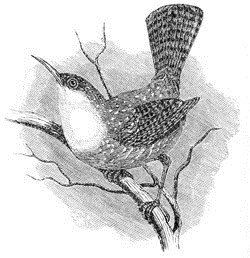
Catherpes mexicanus.
In var. mexicanus the white of throat is more abruptly defined against the rufous of abdomen than in var. conspersus, in which the transition is very gradual. The latter has the secondaries rufous with narrow isolated bars of black; the former has them blackish, indented on lower webs with dark rufous. In mexicanus the feet are very stout, and dark brown; in conspersus they are much weaker, and deep black.
All specimens from south of the United States (including Giraud’s type of Certhia albifrons) belong to the restricted mexicanus, while all from the United States are of the var. conspersus.
Catherpes mexicanus, var. conspersus, RidgwayCAÑON WREN; WHITE-THROATED ROCK WRENTroglodytes mexicanus, Heermann, J. A. N. Sc. 2d ser. II, 1853, 63.—Ib. P. R. R. Rep. X, 1859, 41.—Cassin, Illust. Birds Cal. I, 1854, 173, pl. xxx. Catherpes mexicanus, Baird, Birds N. Am. 1858, 356 (in part); Rev. III (in part).—Cooper, Orn. Cal. 1, 1870, 66. Catherpes mexicanus var. conspersus, Ridgway.
Sp. Char. (No. 53,425 ♂, near Fort Churchill, Nevada, December 7, 1867; R. Ridgway). Above, brownish-ashy on the anterior, and bright cinnamon-rufous on the posterior half, the two colors shading insensibly together. The anterior, or grayish portion thickly sprinkled with numerous small circular dots of white, each preceded by a smaller speck of dusky; a few of these dots on the rump. Wings with obsolete, ragged, narrow, isolated bars of dusky, these most sharply defined on the secondaries. Tail clear rufous, crossed with about nine very narrow, thread-like, somewhat zigzag bars of black,—these about .02 wide on the middle, and .07 on the outer feather. Beneath, anterior third, pure silky-white, shading insensibly into soft ochraceous on the breast, this soon darkening into deep ferruginous, the color of all the posterior lower parts; the whole of this ferruginous surface, with very obsolete transverse spots of white, each preceded by a narrower dusky one. Length, 5.75; extent of wings, 7.50 (fresh); wing, 2.48; tail, 2.13; culmen, .83; tarsus, .56. Bill deep slate, paler, and with lilaceous tinge, at base of lower mandible; iris umber; tarsi and toes black (fresh colors).
Hab. Central region of North America, from boundary of United States northward. Extends up Valley of Colorado. Western Nevada, resident; Ridgway.
The above characters apply to all specimens of Catherpes from north of Mexico, as substantiated by a sufficient series in the collection. It is a remarkable fact that this northern race should be so much smaller than the Mexican one, especially in view of the fact that it is a resident bird in even the most northern parts of its ascertained habitat.
Habits. The geographical distribution of this race of the White-throated Wren, so far as known, is confined to the line of the United States and Mexican boundary, extending northward up the Valley of the Colorado, as far as Western Nevada. The corresponding Mexican race reaches some distance southward, but has not yet been detected beyond the limits of Mexico. The habits of both races, however, are quite similar, as far as known.
Dr. Heermann first met with this Wren in the spring of 1851, on the Cosumnes River. In the following year he procured three specimens on the Calaveras River. He describes it as an active, sprightly bird, having a loud and pleasing song that may be heard a great distance, and which it repeats at short intervals. When found, it was occupied with searching for insects, between and under the large boulders of rock that, in some portions of the river, are thrown together in confused masses, as if by some terrific convulsion of nature.
Dr. Kennerly also met with this species in similar localities among the hills bordering upon the Big Sandy, where the rocks are also described as piled up thick and high. They were darting from rock to rock and creeping among the crevices with great activity, constantly repeating their peculiar and singular note. The great rapidity of their motions rendered it difficult to procure a specimen. He did not observe this bird anywhere else.
Their occurrence equally in such wild and desolate regions and in the midst of crowded cities indicates that the abundance of their food in either place, and not the absence or presence of man, determines this choice of residence. When first observed they were supposed to nest exclusively in deep and inaccessible crevices of rocks, where they were not likely to be traced. Mr. H. E. Dresser afterwards met with its nest and eggs in Western Texas, though he gives no description of either. He found this species rather common near San Antonio, where it remained to breed. One pair frequented a printing-office at that place, an old half-ruined building, where their familiar habits made them great favorites with the workmen, who informed him that the previous spring they had built a nest and reared their young in an old wall close by, and that they became very tame. At Dr. Heermann’s rancho on the Medina he procured the eggs of this bird, as well as those of the Louisiana and Bewick’s Wren, by nailing up cigar-boxes, with holes cut in front, wherever these birds were likely to build.




